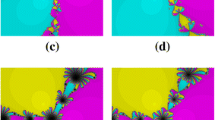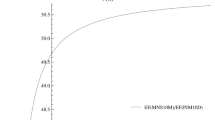Abstract
In this paper, we propose a new higher order iterative method to find multiple roots of nonlinear equations. The combination of Taylor’s series, Newton’s method and the composition approach are used to derive the new method. It requires three evaluations of the function and two evaluations of the derivative of the function per iteration. The theoretical convergence of the proposed method is proved in the main theorem which establishes sixth order of convergence. We compare the developed method with well-known equivalent existing methods by taking various numerical examples. The numerical results demonstrate the better efficiency of the developed method as compared to some standard iterative methods.
Access provided by Autonomous University of Puebla. Download conference paper PDF
Similar content being viewed by others
Keywords
1 Introduction
Solving nonlinear equations is one of the most important problems in applied mathematics, engineering and science. Sometimes, analytical methods are not applicable to solve nonlinear equations. Let \(\psi \) : \( \mathbb {R} \rightarrow \mathbb {R}\) be a nonlinear differentiable function defined on an open interval \( \mathbb {D}\) such that
We use iterative method for solving such nonlinear equations (1), which is defined as
where \(P(\psi )\) is called the iterative function. Newton’s method (NM) [1, 2] is perhaps the most popular root-finding method for solving nonlinear equations, and it is given by
This is quadratically convergent in some neighbourhood of simple roots. Let \(\alpha \) be the root of equation (1) with multiplicity \(\nu > 1\), i.e. \(\psi ^{(i)}(\alpha )=0\) for \(i=1,2,. . ., \nu -1\) and \(\psi ^{(\nu )}(\alpha ) \ne 0\). When used for finding multiple roots of such nonlinear equations, Newton’s method (3) is linearly convergent. The modified Newton’s method [3] is written as
This is quadratically convergent for the equation having multiple roots with multiplicity \(\nu >1\). Many researchers have developed iterative methods using the modified Newton method for solving nonlinear equations having multiple roots.
In 2013, Thukral [4] developed the following new six-order method (TM for short) for finding multiple roots of a nonlinear equation:
where \(n \in \mathbb {N}\).
Geum et al. [5] also developed a new sixth-order method (GM for short) in 2016 which is written as follows:
where \(Q_{\psi }\) and \(K_{\psi }\) are weight functions, \(s_{n}=\bigg (\frac{\psi (y_{n})}{\psi (x_{n})}\bigg )^{\frac{1}{\nu }}\) and \(t_{n}=\bigg (\frac{\psi (z_{n})}{\psi (x_{n})}\bigg )^{\frac{1}{\nu }}\).
In 2017, Qudsi et al. [6] developed the following method (QM for short) of sixth order:
where \(t=\frac{2\psi ^{2}(x_{n})}{\psi (x_{n}+\psi (x_{n}))-\psi (x_{n}-f(x_{n}))}\).
Moreover, Singh et al. [7] developed a new fourth-order method in 2015. In the year 2019, Bhel et al. [8] developed multiple roots version of Ostrowski’s method having fourth order of convergence. W. H. Chanu et al. also proposed an iterative method of fifth order in [9], Qudsi et al. [10] developed a new iterative method of order six, Kattri [11] proposed a new sixth-order iterative method, etc. In this work, we have introduced a higher order iterative method for solving nonlinear equations having multiple roots. In the following sections, we present the development of our new method, numerical results and conclusion.
2 Development of the Method
In this section, we propose a new sixth-order method for determining the multiple roots of nonlinear equation (1) with multiplicity \(\nu >1\) as follows:
Theorem 1
Let \( \alpha \in \mathbb {R}\) be a multiple root of multiplicity \(\nu \) of a sufficiently differentiable function \(\psi : \mathbb {D} \rightarrow \mathbb {R}\) in an open interval \(\mathbb {D}\) which is a subset of \(\mathbb {R}\). Let \(x_0\) be an initial guess of the root \( \alpha \). Then, the method defined by (8) has six orders of convergence.
Proof
Let \(\alpha \) be a root of multiplicity \(\nu \) of \(\psi (x)=0 \) and let \(e_n = x_n - \alpha \) be the error at \( n\textrm{th}\) iteration. Then, using Taylor expansion, we get
where
where
Using the expression of Eqs. (9), (10), (11) and (12) in the second step of the proposed method defined in Eq. (8), we get
where
Using the expression of \(z_n\) from Eq. (13) in the third step of the proposed method defined by Eq. (8), we get
Equation (14) shows that the newly developed method defined by (8) has sixth order of convergence.
3 Numerical Results
In this section, we analyse the computational efficiency of the introduced iterative method (8) using several test functions and compare it with other existing methods. In Table 2, we have displayed the comparison of the convergence of the methods. Table 2 shows the absolute residual error (\(\mid \psi (x_n)\mid \)) of the functions after four full iterations of the methods have been completed. We have compared the newly proposed method (NPM for short) defined in Eq. (8) with the methods given in Eqs. (5), (6) and (7) denoted by TM [4], GM [5] and QM [6], respectively. Mathematica 11.3 software has been used to generate the numerical results in Table 2.
4 Conclusion
We have introduced a new sixth-order iterative method based on Newton’s method for finding multiple roots of nonlinear equations. We compare the newly introduced method with existing methods having the same convergence order using some examples of nonlinear equations. The results given in Table 2, have demonstrated the superiority of the introduced method as compared to the existing methods even though the same examples with the same initial guess are used. It affirms that the introduced iterative method has smaller \(|\psi (x)|\) and simple asymptotic error terms. Therefore, the introduced method is efficient than the other equivalent methods in comparison to finding multiple roots of nonlinear equations.
References
Traub, J.F.: Iterative Methods for the Solution of Equations, Prentice-Hall, Englewood Cliffs, NJ, USA (1964)
Ostrowski, A.M.: Solution of Equations in Euclidean and Banach Space. Academic Press, New York, NY, USA (1973)
Jamaludin, N.A.A., Long, N.N., Salimi, M., Sharifi, S.: Review of some iterative methods for solving nonlinear equations with multiple zeros. Afrika Matematika 30(3–4), 355–369 (2019). https://doi.org/10.1007/s13370-018-00650-3
Thukral, R.: Introduction to higher-order iterative methods for finding multiple roots of nonlinear equations. Hindawi Publ. Corp. J. Math. (2013). https://doi.org/10.1155/2013/404635
Geum, Y.H., Kim, Y.I., Neta, B.: A sixth-order family of three-point modified Newton-like multiple-root finders and the dynamics behind their extraneous fixed points. Appl. Math. Comput. 283, 120–140 (2016). https://doi.org/10.1016/j.amc.2016.02.029
Qudsi, R., Imran, M., Syamsudhuha: another six order iterative method free from derivatives for solving multiple roots of a nonlinear equation. Appl. Math. Sci. 43, 2121– 2129 (2017). https://doi.org/10.12988/ams.2017.76208
Singh, A., Jaiswal, J.P.: An efficient family of optimal fourth-order iterative methods for finding multiple roots of nonlinear equations. Proc. Natl. Acad. Sci. India, Sect. A Phys. Sci. 85, 439–450 (2015). https://doi.org/10.1007/s40010-015-0221-5
Behl, R., Al-Hamdan, W.M.: A 4th-order optimal extension of Ostrowski’s method for multiple zeros of univariate nonlinear functions. Math. MDPI 7(9) (2019). https://doi.org/10.3390/math7090803
Chanu, W.H., Panday, S., Dwivedi, M.: New fifth order iterative method for finding multiple root of nonlinear function. Eng. Lett.29(3) 942–947 (2021)
Qudsi, R., Imran, M., Syamsudhuha: A sixth-order iterative method free from derivative for solving multiple roots of a nonlinear equation. Appl. Math. Sci. 8(2014), 5721–5730. https://doi.org/10.12988/ams.2014.47567
Khattri, S.K.: How to increase convergence order of the newton method to 2m. Appl. Math. 59, 15–24 (2014). https://doi.org/10.1007/s10492-014-0038-6
Author information
Authors and Affiliations
Corresponding author
Editor information
Editors and Affiliations
Rights and permissions
Copyright information
© 2023 The Author(s), under exclusive license to Springer Nature Singapore Pte Ltd.
About this paper
Cite this paper
Panday, S., Chanu, W.H., Devi, Y.N. (2023). New Higher Order Iterative Method for Multiple Roots of Nonlinear Equations. In: Sharma, R.K., Pareschi, L., Atangana, A., Sahoo, B., Kukreja, V.K. (eds) Frontiers in Industrial and Applied Mathematics. FIAM 2021. Springer Proceedings in Mathematics & Statistics, vol 410. Springer, Singapore. https://doi.org/10.1007/978-981-19-7272-0_40
Download citation
DOI: https://doi.org/10.1007/978-981-19-7272-0_40
Published:
Publisher Name: Springer, Singapore
Print ISBN: 978-981-19-7271-3
Online ISBN: 978-981-19-7272-0
eBook Packages: Mathematics and StatisticsMathematics and Statistics (R0)




